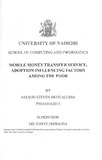| dc.description.abstract | Mobile Money Transfer Service (MMTS) is a wireless network infrastructure facilitating the exchange of cash money and electronic value between various economic actors including clients, financial service providers, businesses and the government. In the past transferring money from a sender to a receiver commonly involved use of Post Office as a formal and secure way. Money send through Post Office took longer period of time before the receiver could access the cash. This delay was undeserved by the poor who lives in a cash economy and is paid in cash. The Banks would have served to reduce time for sending and receiving cash but the poor were again driven away by huge transaction costs levied on money transfer services offered by the banks.
The advent of Mobile Money Transfer Service in Kenya has seen many people utilize the service irrespective of their social status. However; the poor seem to have adopted the Mobile Money Transfer Service, more than they have adopted any other money transfer service. Mobile money appears to have solved issues affecting the poor involving cash handling. The Mobile Money Transfer Service gives the poor a dense network of transaction outlets where they live and work, reducing the cost they incur while accessing financial services. The possibility of Mobile Money Transfer Service providers offering savings, credit, insurance and other products to the poor at low cost, look as if is meant to greatly influence them towards adopting the service. The capability to provide or get Mobile Money Transfer Service anytime any place where there is network coverage is another key driving force for the poor to adopt the service.
Indeed the uptake of Mobile Money transfer service by the poor in Kenya has been spectacular. It is against this interesting uptake that we carried out research on factors influencing adoption of Mobile Money Transfer Service by the poor .We uncovered this by considering the Unified Theory of Acceptance and Use of Technology (UTAUT) Model but included Transaction Cost as another key determinant of adoption of the service, apart from Performance Expectancy, Effort Expectancy, Social Influence, and Facilitating Conditions.
To validate the Unified Theory of Acceptance and Use of Technology Model, survey was the main research methodology. Through stratified random sampling, our sample was drawn from Mobile Money Transfer Service subscribers and dealers/agents of Safaricom’s M-Pesa, Airtel’s Airtel Money and Orange’s Orange money. The outcome of research findings validated the extended Unified Theory of Acceptance and Use of Technology (UTAUT) Model and serve as part of a blue print for deployment and assessment of mobile money services in developing countries where approximately 80% of the population is poor. | en_US |



